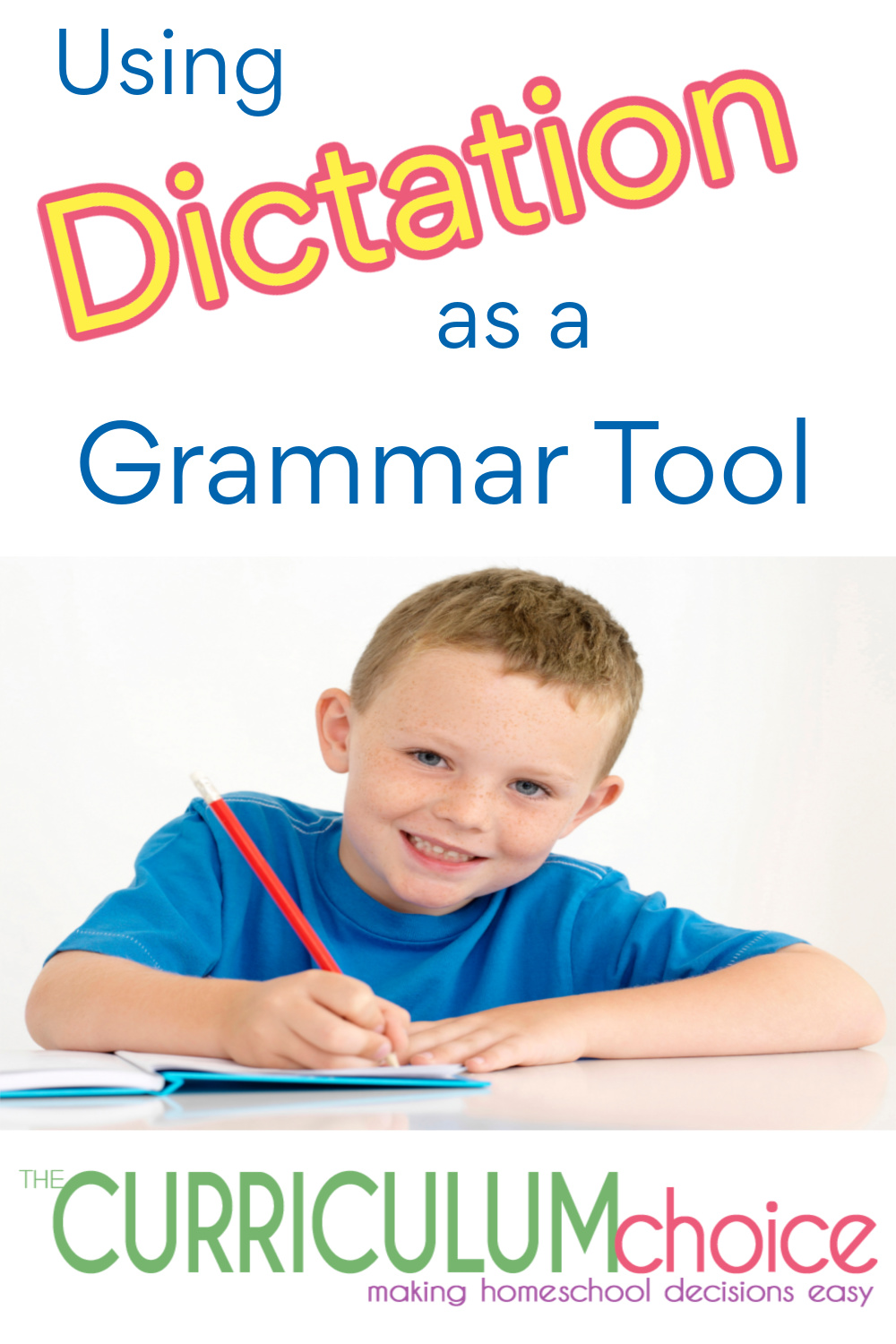What is dictation?
How can I work dictation into our homeschool?
Do I need a special book?
Let’s take a look at dictation and how it can play a vital role in your homeschool.

What is Dictation?
Dictation is the practice of reading a passage to your child and having them dictate, or write it down. You first read the whole passage, then you break it down into bite size chunks for them.
After they complete the passage you check their spelling, punctuation and possibly correct the handwriting if needed.
Dictation vs. Copywork
You may also have heard the term copywork. Copywork is just as it sounds – a student copies a letter, word, sentence, or passage.
Copywork is writing from the written word, dictation is writing from the spoken word.
No matter what age your children are, if you haven’t been doing copywork and dictation in your homeschool, start with copywork. Dictation is an advanced skill and shouldn’t be rushed.
What can be taught through dictation?
You might be surprised just how many language skills can be taught or reinforced through copywork and/or dictation
- Handwriting
- Spelling
- Grammar, usage, and mechanics
- Vocabulary
- Sentence structure and variety
- Use of literary elements and devices
Tips for Beginning Dictation
Like any new skill, it takes time and practice for kids to get comfortable with dictation. Easing them in is a great way to avoid them feeling overwhelmed. Here are some tips for getting started:
- Begin dictating just one or two sentences. Slowly increase the amount of dictation as their skills increase.
- Start with copywork. Assign the sentences or passage as copywork one day, and then use the same passage as dictation the next.
- Let students review the material they will be writing from dictation before you start.
- Don’t hesitate to repeat sentences as many times as you need to. Begin by reading the entire passage and have them listen. Then break it down sentence by sentence or phrase by phrase if needed.
- Exaggerate the pauses. Ask questions to help them along like “What punctuation do we use when there is a pause in the middle of a sentence?”
- Answer their questions. If they ask how to spell a word or what punctuation to use, in the beginning go ahead and answer. Then transition them more and more by asking them to write down their best guess.
Homeschool Methods and Dictation
The purpose of copywork is to get into the child’s visual (and motor) memory the look and feel of a sentence that is correctly composed, and properly spelled, spaced, and punctuated.
Susan Wise Bauer and Jessie Wise, The Well-Trained Mind: A Guide to Classical Education at Home
Copywork and dictation are cornerstones in both Charlotte Mason Homeschooling and Classical Homeschooling.
Be sure to check out our series on Homeschool Methods – What do Homeschool Methods Look Like in Real Life? for more on Charlotte Mason Homeschooling and Classical Homeschooling as well as 6 other homeschool methods!
How can I work dictation into our homeschool?
Children should transcribe favorite passages.– A certain sense of possession and delight may be added to this exercise if children are allowed to choose for transcription their favorite verse in one poem and another. This is better than to write a favorite poem, an exercise which stales on the little people before it is finished. But a book of their own, made up of their own chosen verse, should give them pleasure.
Charlotte, Mason, Home Education, p.238
Get creative! You don’t need a book telling you what to dictate. You can make it a more natural fit with what you are already doing. It will enhance your studies and seal a grammar lesson in the mind of your child.
Here’s a few tips and suggestions for you:
- Pick a passage from a literature book that you are reading for history or for a family read-aloud. Read it out loud and have your child write what they hear. Then go over necessary spelling and grammatical mistakes. Then talk about the uniqueness of the sentence. There are sure to be some grammar pointers in there somewhere. Often, I get questions about punctuation marks (: or ; for instance) and anything I can’t explain, I simply look these up in a grammar reference.
- Pick a poem that you are currently memorizing – or start memorizing one! Or, pick a well-loved poem and have them copy it first, this may take several days. Then one day dictate it and have them write it. Go over the poem as I mentioned above.
- How about a hymn? Hymns have wonderful vocabulary. There are sure to be some words that you can look up (or have an older student look up on their own). And of course, Bible verses are great for dictation too. Especially ones that you are trying to commit to memory.
- How about science? Is there something really neat that you read about in science that maybe sparked an interest in your child? Something from a living book or a science encyclopedia would work well.
For younger children, some good ideas are:
- Days and months
- Address
- Short verse
- Sentence from a beloved book
- Names of family members
- A poem (my kids loved using Shel Silverstein poems, especially ones from Runny Babbit)
Resources/Curriculum for Dictation
Don’t feel comfortable coming up with content for dictation? Here are some resources and curriculum you can use to add dictation into your homeschool.
- BookShark Language Arts integrates dictation exercises into the curriculum. So you don’t have to choose passages. You simply follow the Instructor’s Guide.
- Selections from Excellent Literature
- Great Speeches
- 100 Years: Wisdom from Famous Writers on Every Year of Your Life
- Quotes from Famous People
- Dictation Resource Book (Grades 1-6) This resource book contains ready-to-dictate sentences for each of the Spelling Plus lists, as well as a wealth of resources for using the 1000 core words to teach language skills.
- First Language Lessons for the Well-Trained Mind this scripted guide uses the classical techniques of memorization, copywork, dictation, and narration to develop your child’s language ability in the formative first years of study.
- Poetry
- Brave Writer offers three programs for dictation: Dart (Ages 8-10), Arrow (Ages 11-12), Boomerang (Ages 13-14). These programs select the passages for you and help you to emphasize the literary elements, grammar, spelling, and punctuation to help your kids grow in writing.


Leave a Reply